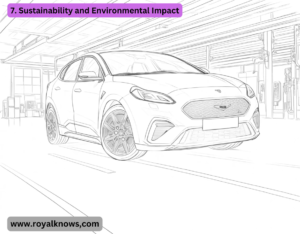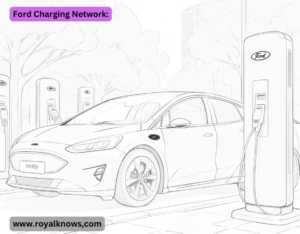Ford Puma Gen E 2025 there is no official information about a Ford Puma Gen E 2025. However, Ford has been actively working on electrifying its lineup, and the Puma, which is currently available as a mild-hybrid and full-hybrid model in Europe, could potentially see a fully electric version in the future.
Fully Electric Powertrain
- Ford Puma Gen E 2025 If Ford introduces a Puma Gen E, it would likely feature a fully electric powertrain, possibly based on Ford’s global EV platform.
- Expected range could be around 300-400 km (186-249 miles) on a single charge, depending on battery size and efficiency.
Design Updates
- The Puma Gen E might retain the compact crossover design but could feature EV-specific styling cues, such as a closed-off grille, aerodynamic enhancements, and unique lighting elements.
Technology and Features
- Advanced driver-assistance systems (ADAS) like Ford’s Co-Pilot360.
- A modern infotainment system with a large touchscreen, wireless connectivity, and over-the-air updates.
- Sustainable materials in the interior to align with Ford’s commitment to eco-friendly manufacturing.
Performance
- Electric motors could deliver instant torque, making the Puma Gen E a fun-to-drive compact SUV.
- Potential for multiple powertrain options, including single-motor (FWD) and dual-motor (AWD) configurations.
Market Positioning
- The Puma Gen E would likely compete with other small electric SUVs like the Peugeot e-2008, Opel MOKKA -e, and Hyundai Kona Electric.
Ford’s Electrification Strategy
- Ford has committed to electrifying its European lineup by 2030, with plans to offer only electric vehicles in Europe by that date. The Puma, being one of Ford’s popular models in Europe, is a strong candidate for electrification.
Platform and Powertrain
- Platform: The Puma Gen E would likely be built on Ford’s Global Electric Platform, which is designed to accommodate a range of compact and mid-sized EVs. This platform would allow for flexible battery sizes and motor configurations.
Battery Options
- A base model with a 50-60 kWh battery, offering around 300-350 km (186-217 miles) of range.
- A long-range model with a 75-80 kWh battery, targeting 400-450 km (249-280 miles) of range.
Motor Options
- Single-motor, front-wheel-drive (FWD) for efficiency and affordability.
- Dual-motor, all-wheel-drive (AWD) for improved performance and traction.
Charging
- Support for DC fast charging (up to 150-200 kW), enabling a 10-80% charge in approximately 30 minutes.
- Standard AC charging for home and public charging stations.
2. Design and Styling
Exterior
- A sleek, aerodynamic design with a closed-off grille (common in EVs) and sculpted body lines.
- LED lighting with signature daytime running lights (DRLs) for a modern, high-tech look.
- Optional two-tone paint schemes and larger alloy wheels (up to 18 or 19 inches).
Interior
- A minimalist, tech-focused cabin with sustainable materials, such as recycled plastics and vegan leather.
- A floating touchscreen (12-15 inches) for the infotainment system, paired with a digital driver display.
- Spacious interior with flexible seating and cargo configurations, maintaining the practicality of the current Puma.
3. Technology and Features
Infotainment
- Ford’s SYNC 4 or SYNC 5 system with wireless Apple Car Play, Android Auto, and voice control.
- Over-the-air (OTA) updates for software improvements and new features.
Connectivity
- Built-in 4G/5G connectivity for real-time navigation, traffic updates, and streaming services.
- Ford Pass app integration for remote control (pre-conditioning, charging status, etc.).
Driver Assistance
- Ford Co-Pilot360 suite, including adaptive cruise control, lane-keeping assist, blind-spot monitoring, and automated parking.
- Potential for Level 2+ autonomous driving capabilities.
4. Performance
Acceleration
- The base single-motor variant could achieve 0-100 km/h (0-62 mph) in around 8-9 seconds.
- The dual-motor AWD variant could reduce this to 6-7 seconds, making it a sporty option in its segment.
Handling
- The Puma Gen E would likely retain the agile handling of the current model, with a low center of gravity thanks to the floor-mounted battery pack.
Driving Modes
- Multiple driving modes (Eco, Normal, Sport, and possibly a customizable mode) to tailor the driving experience.
5. Market and Competition
Target Market
- The Puma Gen E would primarily target urban and suburban drivers in Europe, where compact SUVs are highly popular.
- It would appeal to eco-conscious buyers looking for a practical, stylish, and affordable electric vehicle.
Competitors
- Peugeot e-2008: Similar size and range, with a focus on design and comfort.
- Opel MOKKA-e: Stylish and efficient, with a strong presence in Europe.
- Hyundai Kona Electric: Known for its long range and value for money.
- Volkswagen ID.3: A slightly larger hatchback with a focus on technology and performance.
6. Pricing and Trim Levels
Pricing
- Expected starting price of around €35,000-€40,000 in Europe, positioning it as an affordable electric SUV.
- Higher trims and long-range versions could cost up to €45,000-€50,000.
Trim Levels
- Base Model: Essential features, standard battery, and single-motor FWD.
- Mid-Range: Additional tech features, larger infotainment screen, and enhanced interior materials.
- Top Spec: Dual-motor AWD, long-range battery, premium audio system, and advanced driver-assistance features.
7. Sustainability and Environmental Impact
Ford has been emphasizing sustainability in its manufacturing processes. The Puma Gen E could feature:
- Recycled Materials: Use of recycled plastics, aluminum, and eco-friendly interior materials.
- Carbon Neutrality: Ford may aim for carbon-neutral production for the Puma Gen E, aligning with its broader environmental goals.
- End-of-Life Recycling: Focus on recyclability of battery components and other materials.
8. Expected Launch and Availability
- Unveiling: The Puma Gen E could be unveiled in late 2024, with production starting in early 2025.
- Markets: Initially launched in Europe, followed by other regions depending on demand and infrastructure.
- Sales Targets: Ford would likely aim for strong sales in Europe, where the Puma has been a success in its combustion and hybrid forms.
9. Challenges and Opportunities
Challenges
- Competition in the compact electric SUV segment is fierce, with many established players.
- Ensuring competitive pricing while maintaining profitability.
Opportunities
- Leveraging Ford’s brand reputation and the Puma’s existing popularity.
- Offering a compelling combination of range, performance, and technology at an affordable price.
10. Why the Puma Gen E Matters
- The Puma Gen E would be a crucial addition to Ford’s EV lineup, helping the brand meet its electrification goals and compete in the growing compact electric SUV market.
- It would also demonstrate Ford’s ability to adapt its popular models to the electric era, appealing to both existing customers and new buyers.
Advanced Battery Technology
Battery Chemistry:
- The Puma Gen E could utilize lithium-ion batteries with nickel-manganese-cobalt (NMC) chemistry, offering a balance of energy density, longevity, and cost-effectiveness.
- Ford might also explore solid-state batteries in the future, but these are unlikely to be ready for mass production by 2025.
Thermal Management:
- Advanced liquid cooling systems to maintain optimal battery temperature, ensuring consistent performance and longevity.
Battery Warranty:
- A standard 8-year/160,000 km (100,000 miles) warranty for the battery, covering significant capacity loss (e.g., below 70% of original capacity).
12. Charging Infrastructure and Ecosystem
Ford Charging Network:
- Access to Ford’s growing network of charging stations, including partnerships with third-party providers like IONITY in Europe.
- Seamless integration with Ford Pass, allowing drivers to locate, reserve, and pay for charging sessions directly through the app.
Home Charging:
- Ford could offer a home charging station as an optional accessory, capable of delivering up to 11 kW for overnight charging.
- Compatibility with solar power systems for eco-conscious buyers.
Bidirectional Charging:
- Potential support for vehicle-to-grid (V2G) or vehicle-to-home (V2H) technology, allowing the Puma Gen E to power homes or feed energy back into the grid during peak demand.
13. Interior Innovation
Flexible Seating and Storage:
- A modular interior with sliding rear seats and fold-flat configurations to maximize cargo space.
- Underfloor storage compartments for charging cables or personal items.
Ambient Lighting:
Customizable ambient lighting with multiple color options to enhance the cabin atmosphere.
Advanced Sound System:
- A premium audio system from a brand like B&O Play, offering immersive sound quality.
- Augmented Reality (AR) Head-Up Display:
- An optional AR head-up display that projects navigation, speed, and other critical information onto the windshield.
Get article on pdf file…Click now
……………Ford Puma Gen E 2025………….




